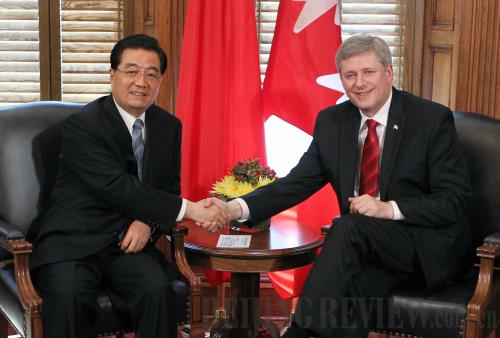| 
If Canadian Prime Minister Stephen Harper's visit to China last December led to a thaw in the frozen Sino-Canadian relations in recent years, Chinese President Hu Jintao's latest trip to Ottawa appeared to usher in yet another warm period for these deep-rooted relations.
Sino-Canadian ties are, first and foremost, grounded in the close contacts between the Chinese and Canadian peoples. Every year, more than 700,000 visitors cross the Pacific between the two countries—an average of 2,000 on a daily basis. More than 1.4 million people of Chinese origin currently reside in Canada, while nearly 60,000 Chinese students study there. Chinese immigrants have become one of the largest ethnic groups in Canada's immigrant population, making Chinese the third most popular language in Canada next to English and French. Moreover, there are 44 pairs of sister cities and provinces in the two countries.
Progress and setbacks
 |
|
A NEW LEAF: Visiting Chinese President Hu Jintao talks with Canadian Prime Minister Stephen Harper on bilateral political, economic and cultural ties in Ottawa on June 24 (FAN RUJUN) | Canada forged diplomatic relations with China in 1970, one of the first Western countries to do so. The two nations' cooperation has since made great strides with the support of their governments. In addition to increasingly frequent exchanges of visits by government leaders at different levels, they have created more than 40 mechanisms for cooperation in various areas including trade, law enforcement, energy, environmental protection, science, education, culture and health. Both countries have also worked together in multilateral institutions such as the UN, the World Trade Organization, the Group of 20 and the Asia-Pacific Economic Cooperation.
Despite the remarkable progress, however, bilateral relations have experienced fluctuations in the 21st century. The Canadian Government under Prime Minister Harper, who took office in February 2006, took a series of measures that cast a chill over Sino-Canadian ties.
Relations did not turn around until July 2008, when Hu and Harper met on the sidelines of the Group of Eight outreach session in Japan. At the meeting, the leaders reached major agreements on boosting Sino-Canadian relations, which gave impetus to their cooperation in various fields.
In December of the following year, Harper paid his first official visit to China. During the visit, the two countries issued a joint statement, while signing a number of documents covering fields ranging from climate change to culture, agriculture and education.
In the joint statement, the two countries said they were committed to a "steady and positive forward momentum" in their overall relationship. They also reaffirmed the fundamental principle of respecting each other's sovereignty, territorial integrity, core interests and major concerns. Neither side supports any attempts to undermine this principle.
While China emphasized the question of Taiwan concerns its sovereignty and territorial integrity, Canada reiterated its support for the "one-China policy." Both sides recognized that each country and its people have the right to choose their own development path, and that all countries should respect each other's choice of development model. The two sides also agreed to increased dialogue on human rights.
In terms of business ties, the two countries acknowledged the complementary nature of their economic and trade ties, with each promising to welcome investment from the other. With these commitments and more, Harper's visit turned over a new page in Sino-Canadian relations.
Hu's visit to Canada in June, the second visit to the North American country by the Chinese president since 2005, came as part of the celebrations commemorating the 40th anniversary of the two countries' diplomatic relations.
During the visit, Hu held talks with Prime Minister Harper and Governor General Michaëlle Jean, addressing issues concerning bilateral relations as well as regional and international affairs. He also met with other Canadian officials while engaging extensively with representatives from all sections of Canadian society. Meanwhile, the two countries' government departments and companies signed a series of agreements. All these made Hu's trip a great success.
Trade focus
Trade has always been a bright spot in Sino-Canadian relations. Two-way trade jumped to $34.52 billion in 2008 from $150 million when the two countries first established diplomatic relations. This shows they fulfilled the target their leaders set in September 2005 to raise bilateral trade volume to more than $30 billion by 2010 ahead of schedule.
China is now Canada's second biggest trade partner, its third biggest export market and its second biggest source of imports. Moreover, the third phase of the Qinshan Nuclear Power Plant in east China's Zhejiang Province, which operates with Canadian nuclear reactors, offers a telling example of the two countries' collaboration in developing nuclear energy for civilian purposes.
Sino-Canadian trade only represents a small fraction of the two countries' total foreign trade volume—1 percent for China and 6 percent for Canada. Canada's investment in China accounts for less than 1 percent of the total foreign investment China has received. There is, therefore, huge potential for China and Canada, to increase trade and investment.
Canada has given priority to China in its Asia-Pacific Gateway and Corridor Initiative in a bid to explore new areas of bilateral trade and investment growth. The initiative, launched in 2006, aims to facilitate global supply chains by creating a transportation network linking North America with Asia. To that end, the Canadian Government has announced it will invest nearly Canadian $2.5 billion ($2.4 billion) in infrastructure construction, including more than Canadian $900 million ($865 million) from the federal government. The Chinese Government has said it welcomes and supports this initiative.
|
